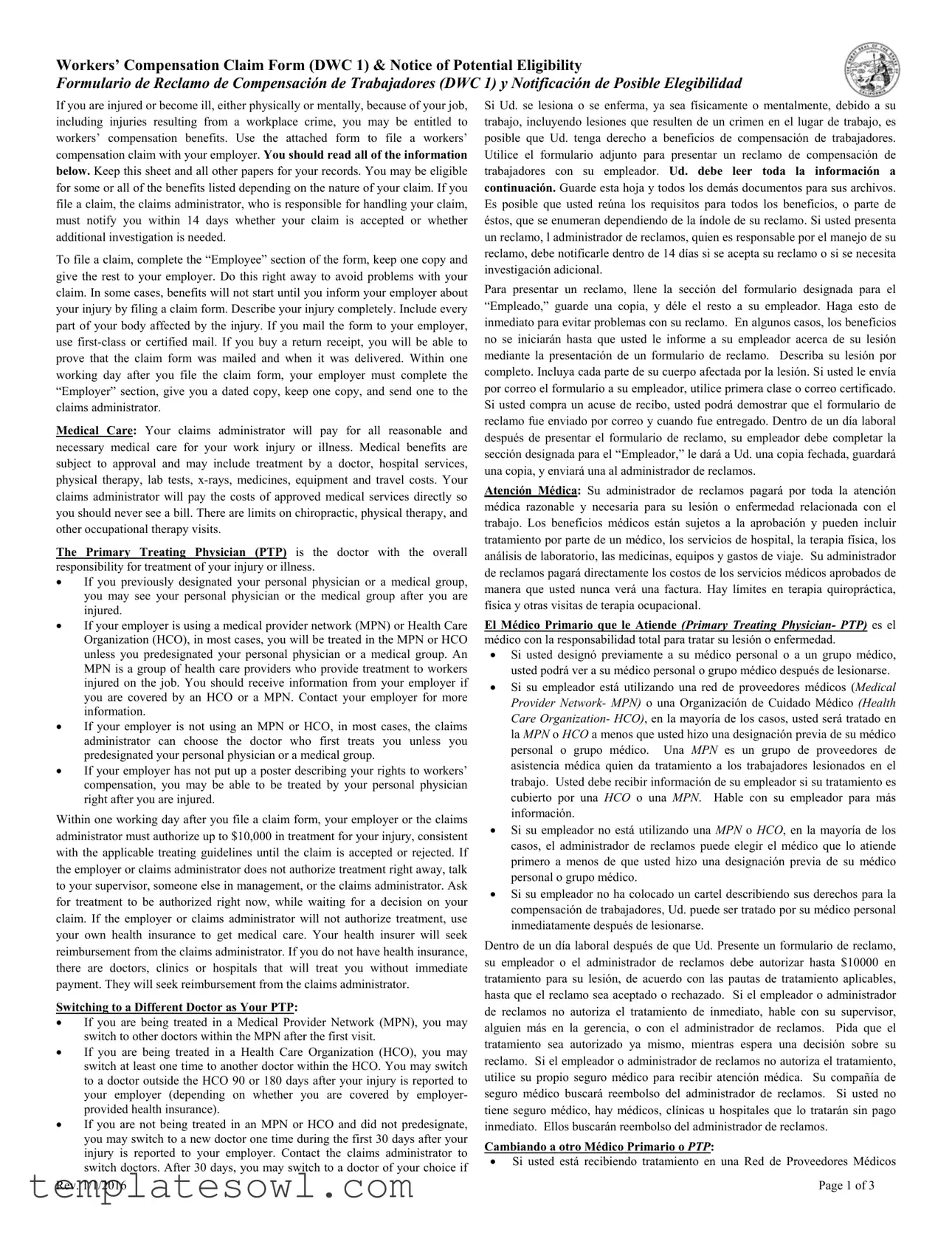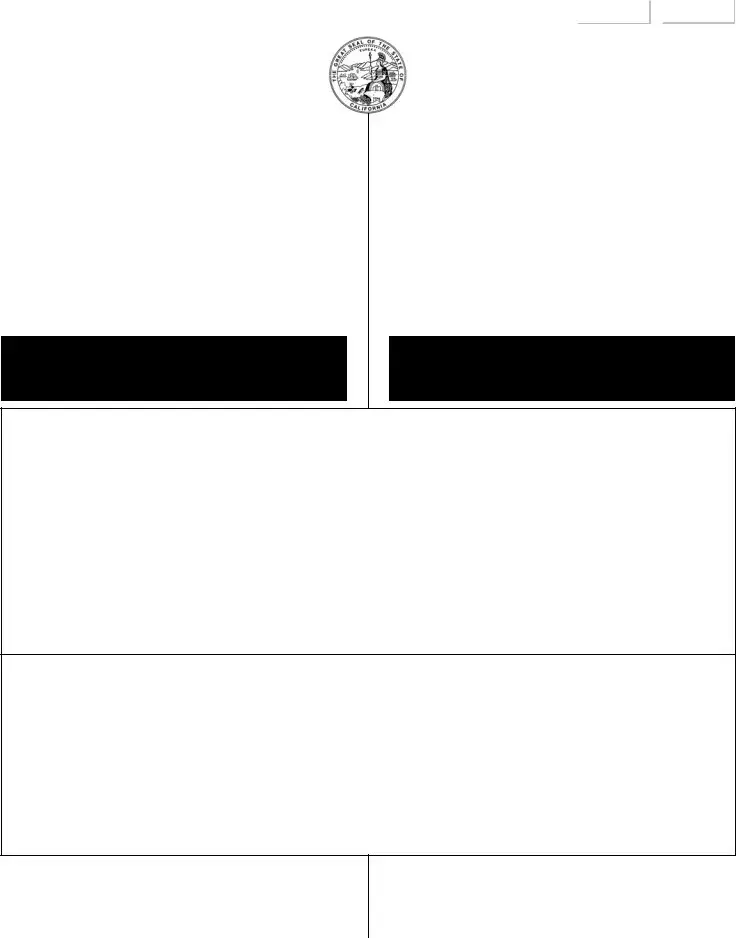If you are injured or become ill, either physically or mentally, because of your job, including injuries resulting from a workplace crime, you may be entitled to workers’ compensation benefits. Use the attached form to file a workers’ compensation claim with your employer. You should read all of the information below. Keep this sheet and all other papers for your records. You may be eligible for some or all of the benefits listed depending on the nature of your claim. If you file a claim, the claims administrator, who is responsible for handling your claim, must notify you within 14 days whether your claim is accepted or whether additional investigation is needed.
To file a claim, complete the “Employee” section of the form, keep one copy and give the rest to your employer. Do this right away to avoid problems with your claim. In some cases, benefits will not start until you inform your employer about your injury by filing a claim form. Describe your injury completely. Include every part of your body affected by the injury. If you mail the form to your employer, use first-class or certified mail. If you buy a return receipt, you will be able to prove that the claim form was mailed and when it was delivered. Within one working day after you file the claim form, your employer must complete the “Employer” section, give you a dated copy, keep one copy, and send one to the claims administrator.
Medical Care: Your claims administrator will pay for all reasonable and necessary medical care for your work injury or illness. Medical benefits are subject to approval and may include treatment by a doctor, hospital services, physical therapy, lab tests, x-rays, medicines, equipment and travel costs. Your claims administrator will pay the costs of approved medical services directly so you should never see a bill. There are limits on chiropractic, physical therapy, and other occupational therapy visits.
The Primary Treating Physician (PTP) is the doctor with the overall responsibility for treatment of your injury or illness.
If you previously designated your personal physician or a medical group, you may see your personal physician or the medical group after you are injured.
If your employer is using a medical provider network (MPN) or Health Care Organization (HCO), in most cases, you will be treated in the MPN or HCO unless you predesignated your personal physician or a medical group. An MPN is a group of health care providers who provide treatment to workers injured on the job. You should receive information from your employer if you are covered by an HCO or a MPN. Contact your employer for more information.
If your employer is not using an MPN or HCO, in most cases, the claims administrator can choose the doctor who first treats you unless you predesignated your personal physician or a medical group.
If your employer has not put up a poster describing your rights to workers’ compensation, you may be able to be treated by your personal physician right after you are injured.
Within one working day after you file a claim form, your employer or the claims administrator must authorize up to $10,000 in treatment for your injury, consistent with the applicable treating guidelines until the claim is accepted or rejected. If the employer or claims administrator does not authorize treatment right away, talk to your supervisor, someone else in management, or the claims administrator. Ask for treatment to be authorized right now, while waiting for a decision on your claim. If the employer or claims administrator will not authorize treatment, use your own health insurance to get medical care. Your health insurer will seek reimbursement from the claims administrator. If you do not have health insurance, there are doctors, clinics or hospitals that will treat you without immediate payment. They will seek reimbursement from the claims administrator.
Switching to a Different Doctor as Your PTP:
If you are being treated in a Medical Provider Network (MPN), you may switch to other doctors within the MPN after the first visit.
If you are being treated in a Health Care Organization (HCO), you may switch at least one time to another doctor within the HCO. You may switch to a doctor outside the HCO 90 or 180 days after your injury is reported to your employer (depending on whether you are covered by employer- provided health insurance).
If you are not being treated in an MPN or HCO and did not predesignate, you may switch to a new doctor one time during the first 30 days after your injury is reported to your employer. Contact the claims administrator to switch doctors. After 30 days, you may switch to a doctor of your choice if
Rev. 1/1/2016
Si Ud. se lesiona o se enferma, ya sea físicamente o mentalmente, debido a su trabajo, incluyendo lesiones que resulten de un crimen en el lugar de trabajo, es posible que Ud. tenga derecho a beneficios de compensación de trabajadores. Utilice el formulario adjunto para presentar un reclamo de compensación de
trabajadores con su empleador. Ud. debe leer toda la información a
continuación. Guarde esta hoja y todos los demás documentos para sus archivos. Es posible que usted reúna los requisitos para todos los beneficios, o parte de éstos, que se enumeran dependiendo de la índole de su reclamo. Si usted presenta un reclamo, l administrador de reclamos, quien es responsable por el manejo de su reclamo, debe notificarle dentro de 14 días si se acepta su reclamo o si se necesita investigación adicional.
Para presentar un reclamo, llene la sección del formulario designada para el “Empleado,” guarde una copia, y déle el resto a su empleador. Haga esto de inmediato para evitar problemas con su reclamo. En algunos casos, los beneficios no se iniciarán hasta que usted le informe a su empleador acerca de su lesión mediante la presentación de un formulario de reclamo. Describa su lesión por completo. Incluya cada parte de su cuerpo afectada por la lesión. Si usted le envía por correo el formulario a su empleador, utilice primera clase o correo certificado. Si usted compra un acuse de recibo, usted podrá demostrar que el formulario de reclamo fue enviado por correo y cuando fue entregado. Dentro de un día laboral después de presentar el formulario de reclamo, su empleador debe completar la sección designada para el “Empleador,” le dará a Ud. una copia fechada, guardará una copia, y enviará una al administrador de reclamos.
Atención Médica: Su administrador de reclamos pagará por toda la atención médica razonable y necesaria para su lesión o enfermedad relacionada con el trabajo. Los beneficios médicos están sujetos a la aprobación y pueden incluir tratamiento por parte de un médico, los servicios de hospital, la terapia física, los análisis de laboratorio, las medicinas, equipos y gastos de viaje. Su administrador de reclamos pagará directamente los costos de los servicios médicos aprobados de manera que usted nunca verá una factura. Hay límites en terapia quiropráctica, física y otras visitas de terapia ocupacional.
El Médico Primario que le Atiende (Primary Treating Physician- PTP) es el médico con la responsabilidad total para tratar su lesión o enfermedad.
Si usted designó previamente a su médico personal o a un grupo médico, usted podrá ver a su médico personal o grupo médico después de lesionarse.
Si su empleador está utilizando una red de proveedores médicos (Medical Provider Network- MPN) o una Organización de Cuidado Médico (Health Care Organization- HCO), en la mayoría de los casos, usted será tratado en la MPN o HCO a menos que usted hizo una designación previa de su médico personal o grupo médico. Una MPN es un grupo de proveedores de asistencia médica quien da tratamiento a los trabajadores lesionados en el trabajo. Usted debe recibir información de su empleador si su tratamiento es cubierto por una HCO o una MPN. Hable con su empleador para más información.
Si su empleador no está utilizando una MPN o HCO, en la mayoría de los casos, el administrador de reclamos puede elegir el médico que lo atiende primero a menos de que usted hizo una designación previa de su médico personal o grupo médico.
Si su empleador no ha colocado un cartel describiendo sus derechos para la compensación de trabajadores, Ud. puede ser tratado por su médico personal inmediatamente después de lesionarse.
Dentro de un día laboral después de que Ud. Presente un formulario de reclamo, su empleador o el administrador de reclamos debe autorizar hasta $10000 en tratamiento para su lesión, de acuerdo con las pautas de tratamiento aplicables, hasta que el reclamo sea aceptado o rechazado. Si el empleador o administrador de reclamos no autoriza el tratamiento de inmediato, hable con su supervisor, alguien más en la gerencia, o con el administrador de reclamos. Pida que el tratamiento sea autorizado ya mismo, mientras espera una decisión sobre su reclamo. Si el empleador o administrador de reclamos no autoriza el tratamiento, utilice su propio seguro médico para recibir atención médica. Su compañía de seguro médico buscará reembolso del administrador de reclamos. Si usted no tiene seguro médico, hay médicos, clínicas u hospitales que lo tratarán sin pago inmediato. Ellos buscarán reembolso del administrador de reclamos.
Cambiando a otro Médico Primario o PTP:
Si usted está recibiendo tratamiento en una Red de Proveedores Médicos Page 1 of 3


